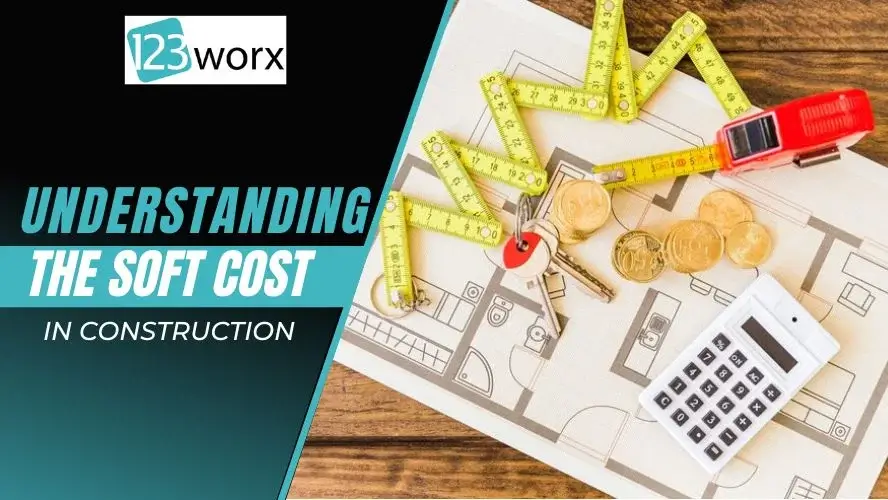Every construction professional manages numerous projects simultaneously, with the main focus always on physical construction materials, labor, and equipment. Soft costs, often overlooked, can have a significant impact on the complete success of a project. Soft costs, also called indirect costs, present a myriad of other expenses that may not be directly linked with the actual construction process but are necessary to complete the project.
In this blog, we’ll delve deep into everything regarding soft costs in a construction project, their nature, effect, and how they can be managed.
Knowing the importance of these costs will lead to value-based judgment, ensuring better optimization of the project budget and making your project a success.
Differentiating Between Hard Costs And Soft Costs
Before delving deeper into the details of soft costs, it would be crucial to differentiate the two types of costs. Hard costs, also called direct costs, are those directly related to the physical construction process, including materials, labor, rentals for equipment, and on-site utilities. These costs are generally more quantifiable and directly linked to construction.
On the other hand, soft costs represent all other indirect costs that do not directly relate to physical construction but support the construction process. These are usually ignored or underrepresented and could contribute to the likely overrun of costs and work delays.
Common Examples of Soft Costs in Construction
Soft costs are indirect costs within construction and include items such as:
1. Pre-construction costs:
- Architectural and engineering fees
- Environmental studies and site surveys
- Allowing and Zoning Charges
- Legal and advisor fees
2. Administrative costs:
- Construction Project management and supervision
- Insurance and Bonding
- Accounting and Financial Services
- Marketing and publicity
3. Financing costs:
- Loan origination fees
- Costs of financial interest during construction
- Closing costs
4. Operational Expenditure:
- Starting up and testing
- Punch List and Warranty Work
- As-Built Documentation
- Licenses and Inspections
Project type, location, and scope may vary the definite soft costs.
The Impact of Soft Costs on Project Budgets
Soft costs are usually overlooked, but they can significantly impact the project budget. This can cause project budget overruns, delays, and financial stress. Soft costs sometimes reach up to 30% of the total project cost. That’s why proper management and due consideration of these costs are critical steps towards a winning project.
Soft costs are inaccurately estimated and managed, thus:
- Cost Overruns and Budget Deficits
- Project completion delays
- Compromised quality, or quantity reductions
- Strained relationships with stakeholders and contractors
- Among these, the possible consequential financial and legal aspects
Soft costs are just as important as hard costs therefore, proper resources and planning efforts are needed to manage them correctly during the project.
Strategies For Managing And Reducing Soft Costs
In every construction projects, soft costs always exist. Yet, there are ways to manage and possibly bring down these costs.
- Comprehensive planning and budgeting: Proper research and analysis during pre-construction is critical. This leads to understanding all potential indirect costs. Learn from other industries and seek help from seasoned professionals to make a sensible budget.
- Value engineering: Seek alternative solutions in design and materials, or alternative approaches in construction, which lower the soft cost without affecting the function and quality of the project. Work with architects, engineers, and contractors to identify cost-saving opportunities.
- Streamlined processes: Smooth management of projects, use of technology tools, and effective communication with the stakeholder’s aid in promoting seamless operations with minimal delays, do-overs, and paperwork.
- Procurement policy: Negotiate down fees, rates of interest, and other soft costs payable to consultants, service providers, and lenders for their services.
- Risk mitigation: Identification and proactive management of potential risks that may result in other soft costs—for example, time delays, litigation, and unforeseen site conditions.
- Continuous monitoring and control: Expenditures on soft costs should be periodically reviewed and monitored throughout the project life cycle, during which any needed adjustments can then be made to maintain alignment of project budgets. This also avoids costing more than planned.
In the hands of adept construction professionals, soft costs can potentially be managed and reduced. With the right use of resources, projects get more efficient, and strategic approaches boost the earnings from these projects.
Importance of budgeting for soft costs in construction projects
If soft costs aren’t planned correctly for construction projects, things can go terribly wrong. Major financial issues can arise without proper consideration and the correct allocation of resources to meet these expenses. In most extreme cases, this could cause delays, reduce the project’s size, or even cancel the whole thing.
Budgeting for soft costs is crucial for several reasons:
- Realistic Project Cost Estimation: Estimating soft costs within the project’s overall budget allows stakeholders to grasp the total project cost realistically, hence making sound decisions and proper resource allocation.
- Better cash flow management: Proper accounting for soft costs makes it easier to plan and forecast cash flow so that an organization knows it has the money it needs when it needs it to cover such expenses.
- Cost overrun aversion: Underestimation or neglect of soft costs can lead to cost overruns. This, in turn, can stress project finances and sometimes even risk the project’s survival.
- Confidence from Stakeholders: Proper budgeting for soft costs shows an extent of professional thoroughness in project planning, thus helping develop confidence in stakeholders, investors, and lenders.
- Compliance and risk mitigation: The task includes several soft costs. They have to be considered in the project, as they ensure compliance with set regulations and mitigate potential risks.
Budgeting the right amount for soft-cost resources enables construction professionals to control the project financially and, in the process, reduce risks and successfully deliver the project.
Tools And Technologies To Streamline Soft Cost Management
With the right tools and technologies, modern construction can become much more straightforward. Digital solutions allow construction professionals to be more effective and efficient, promote improved collaboration, and provide a view of soft cost expenses.
Here are some powerful tools and technologies:
- Project management software: Complete project management software like 123worx or Procore and PlanGrid are well equipped with soft cost tracking and management features. The software also allows for centralized dashboards, real-time reporting, and even have features that promote communication and teamwork among project stakeholders.
- Cost Estimating and Budgeting: There are top-notch software tools tailor-made to give price estimates for construction projects. Software like 123worx, Sage Estimating, Construction Cost Estimating Software (CCES), and RS Means Data Online do this well. These software uses historical data, standard benchmarks, and more advanced machine-learning algorithms to derive accurate soft cost estimates. As a result, they have features that can give complete budgets.
- Cloud-based document management: Most construction management software now a days are cloud-based and they offer digital document management. In the absence of construction management software, platforms such as Dropbox, Box, and Google Drive make document storage convenient and safer. This make file sharing more streamlined, and useful for project teamwork like mutual project plans, invoices, and indirect cost records—more focused
- Building Information Modeling (BIM): It integrates the use of software such as Autodesk Revit and Trimble SketchUp to create and manage a digital representation of a construction project. These help with improved coordination, clash detection, and cost estimation. As a result, it reduces the chance of potential soft costs related to rework and delays.
- Mobile applications: Mobile applications are used by field teams to record and share data in real time, document progress, and communicate issues. This allows the softer cost expenditures to be monitored and controlled more effectively.
- Artificial intelligence and machine learning: Emerging AI and ML technologies are empowering the revolution in the construction industry. The technology provides predictive analytics and risk assessment with automatically created cost estimations, meaning less worry over budgeting errors. All this makes the job easier for construction professionals to make decisions driven by optimized data in soft cost management.
These tools and technologies streamline processes, help professionals work more effectively, make team collaboration more accessible, and promote clear view of invisible costs and expenditures. This results in efficient delivery and saves money.
Collaborating With Stakeholders To Optimize Soft Costs
Handling soft cost management requires collaboration and open communication between the various stakeholders involved in the construction project. If everyone’s skills and knowledge are used together collaboratively, the opportunity cost will be identified in construction, which will help in implementing strategies to reduce soft costs.
Here are some key parties involved in the soft costs’ optimization:
- Project Owner and Developer: A project owner and developer would establish the project’s financial goals and the whole project budget, including the soft cost budget. Their input is vital to the value engineering exercises and decisions affecting soft cost optimization.
- Architects and Engineers: Experts who understand building codes, rules, and practical challenges. Their early involvement can highlight potential areas of non-physical costs and suggest cost-efficient alternatives. These alternatives both meet project needs and reduce needless expenditure.
- Construction managers and contractors: Construction managers and contractors have hands-on experience with project execution. They can offer useful suggestions for better work processes, identify possible problems, and find cost-effective building techniques. These can lower extra expenses associated with delay, do-overs, and office costs.
- Financial advisors and lenders: It is important to closely work with financial advisors and lenders to secure the most favorable and cost-effective terms for financing; and negotiate for the best financing terms and alternative funding options that will reduce the soft costs of financing and borrowing.
- Legal and regulatory consultants: Consultants can be quite helpful in identifying compliance issues, navigating complex permitting processes, and mitigating risks arising from legal disputes or fines. This should be done as early in the project as possible.
- Technology providers: Working with technology companies that provide specialized construction software or BIM solutions or invent new tools makes project management, communication, and data-driven decision-making easier. Therefore, this solution saves money and reduces soft costs, which result from inefficiency.
With a broad perspective, construction teams can swap ideas for industry improvement. They look for ways to implement cost-saving strategies and effectively manage soft costs throughout the project life cycle.
Clear Understanding of Soft Costs
A good understanding of soft costs is vital. Implementing proper management strategies and maximizing your tech and teamwork options is also essential. All these can help construction professionals deal with these costs skillfully, leading to better project results.
As the construction industry hurtles toward the future, it’s essential to keep a complete eye on the proactive management of soft costs.
Appreciation of the need for, and best practice regarding, soft costs within project planning and implementation means that construction ventures can be effectively completed to meet the changing needs of our industry and stakeholders.

As a Vice President at 123worx, Construction Management Platform, Bharat Rudra has worked with hundreds of business executives searching for best-suited software for their construction business with a wide array of requirements. Bharat takes pride in helping construction businesses solve their business and project management challenges. Feel free to reach Bharat if you have any questions. You can find him on LinkedIn or reach him at brudra@123worx.com

